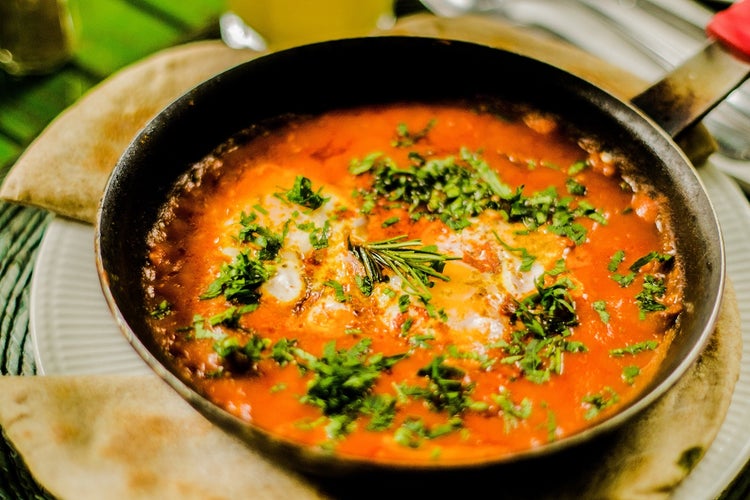8 Secrets of Warming Soups and Stews

As the leaves fall and the air takes on a chill, nothing comforts like a warm soup or stew simmering on the stove. Fortunately, preparing these nourishing meals is economical and easy. (After all, there’s only one pot to clean!) In fact, the basic technique is virtually the same for all varieties. Read on to learn those key steps. Then improvise with your preferred ingredients (such as those limp carrots you’ve been meaning to use).
- First, saute a flavorful base.
Start by heating a small amount of fat, such as olive or avocado oil, over medium heat in a Dutch oven, saucepot or stockpot. Once the oil is warm, add some meat, if using. Try ground beef or turkey, or sausage (with the latter, just discard the casings and add the filling). Saute until fully cooked through (the meat will be opaque and white, if chicken; brown, if beef or lamb; or dark pink, if pork), then leave in the pot. If including larger chunks of meat, such as pieces of chuck roast, saute until brown and then transfer to a plate. (You will finish cooking the meat later in the process.) If a lot of fat remains in the pot, carefully pour out and discard it.
Now, add diced hardier vegetables, such as red onions, carrots and celery (this combination is called a mirepoix), diced white or sweet potatoes, turnips, parsnips or more. Saute for about five minutes. (The vegetables will finish cooking through later.)

While sauteing the meat and vegetables, add some salt, black pepper and other spices. “A well-stocked spice cabinet is paramount to successful soup making, as soup derives much of its flavor from the addition of spices,” says Carolyn Ketchum, author of “Keto Soups & Stews” (Victory Belt Publishing, 2018). At a minimum, she suggests stocking up on bay leaves, cayenne, chili powder, cumin, curry powder, garlic powder, ginger, paprika, red pepper flakes, dried sage and dried thyme.
Try to match the seasoning with the theme of the dish. So if you’re whipping up a Moroccan stew, season with cumin, coriander, cayenne and cinnamon. For a Spanish dish, opt for garlic powder and smoked paprika, while for an Italian meal, you’ll want to reach for dried oregano and crushed red pepper flakes.
Along with those spices, also stir in tomato paste, if using. This umami-rich ingredient adds intense flavor, plus a hit of acid. At the same time, you also can whisk in some flour (such as white whole wheat) to thicken your soup or stew.
- Pour in flavorful broth or stock.
Now, add lots of your broth or stock. “As long as you have some broth, you can always have soup,” Ketchum says. “Think of the liquid that you add to your soup or stew as the skeleton of your dish. Chicken broth is the most neutral in flavor, and I use it for everything from vegetable soups to fish chowder. Leftover meats and some veggies can go into the pot and voilà!” Be sure to choose a flavorful variety, such as a bone broth, she adds. Either do it yourself or find a low-sodium product so you can control the saltiness of the dish.
- Add more oomph with power ingredients.
Since a high percentage of a soup or stew is water, these dishes can become bland. That’s why it’s a good idea to incorporate some high-impact ingredients. To add umami, try tomato paste, soy sauce, chopped roasted red peppers, minced dried mushrooms or the rind from Parmigiano-Reggiano cheese. (The latter sounds odd but works beautifully in pumpkin or sweet potato dishes and minestrone-like soups.) To avoid ending up with a salt bomb, watch how much extra salt you add—especially if you’re also working with miso paste, soy sauce or cheese rind. To bring your dish to life, add an acidic ingredient, such as fresh citrus juice, vinegar, apple cider, beer or wine, or dried apricots. For instance, orange juice enhances tomato soup, white balsamic vinegar minestrone, beer chili, and cider pork and apple stew.
- Stir in remaining elements.
Thicken your soup or stew with canned pumpkin or canned beans (mashed or whole). You also can include lentils or rinsed pearl barley or quinoa (which cook in about 15 to 20 minutes). In all these cases, stir these ingredients in when you add your stock or broth. At this point, also stir back in any large browned pieces of meat. Now that you’ve added all your elements, bring the soup or stew to a boil over high heat.
- Cover and simmer.
The second the mixture comes to a boil, cover the pot. Then reduce the heat to medium-low to low and cook gently for anywhere from about 30 minutes to two or three hours. Most soups and stews are quick to prepare. However, stews with large pieces of tough cuts of meat (such as chuck roast or brisket) will take longer. If cooking for a long time, consider transferring the saucepot to a low oven (set at about 300 F). Ingredients should simmer rather than boil. Boiling will likely overcook the vegetables and render meat tough. To make sure the soup or stew is cooked through, use a fork to poke the ingredients: Both the meat and vegetables should be tender. If you used a cheese rind, remember to remove it.
- Add noodles, miso paste or greens.
If adding noodles, stir in and cook until tender. For varieties that take several minutes, consider boiling them separately and then adding them to the finished soup or stew. Try referencing the package directions for cook times and incorporating the noodles that many minutes before your dish will be cooked. With umami-rich miso paste, whisk in a bowl with some of the hot liquid, then add back to the hot soup a few minutes before serving. For greens, such as chopped fresh kale, spinach or Swiss chard leaves (stems removed), add toward the end and simmer until tender, anywhere from one to five minutes.
- Get thick and creamy.
For creamy soups, blend the entire recipe or just a portion of it. To do so, use a stick (immersion) blender and puree in the pot or go with a blender. “Blending just a ladleful or so of any unblended soup and re-adding to the pan for a final reheat adds creaminess and richness without the addition of any cream or butter,” says Alice Hart, author of “The Way to Eat Now: Modern Vegetarian Food” (The Experiment, 2019). “It takes only a minute but is really effective.” If using a blender, fill the blender jar no more than two-thirds full and cover it while pureeing.
- Finish it off.
Always taste the finished soup or stew before serving and adjust the seasonings, if necessary. You might need to add more salt or vinegar, for example. Then enhance the finished dish with contrasting toppings, such as cold, creamy yogurt or chopped fresh scallions. For instance, Hart tops her red pepper and pumpkin soup with toasted pumpkin seeds, cold yogurt and fresh cilantro leaves. “It’s easy to do and will completely alter the soup and add some bonus nutrients in the process. It also works to jazz up store-bought soup when you’re short on time and need your dish to look and taste a little more special,” she says.
Flavor Inspirations
Now that you know the basic technique for soups and stews, try inventing your own recipes using these flavor concepts.
- Sweet potato or butternut squash soup with Parmesan rind and fresh sage, garnished with toasted pumpkin seeds
- Tomato soup with fresh orange juice and dried oregano, topped with grated Parmigiano-Reggiano cheese
- Beef and bean chili with ground beef, canned pinto beans, beer and chili powder, topped with guacamole and a lime wedge
- Sausage and kale stew with Italian sausage, kale, canned tomatoes and Parmesan rind
Photo credit: Pez González